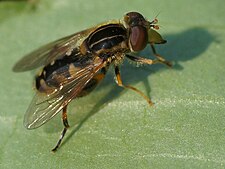
Eumerus is a genus of hoverflies, within the tribe Eumerini.

Dasysyrphus is a genus of hover flies with 50 identified species distributed worldwide. While the genus is relatively easy to identify, genera key the differences between species have a more narrow range of variations. Therefore, identification of species by images of specimens alone should be made with care.

Blera is primarily a North American genus, though there are 3 species from Europe. The genus is characterized by the following characters:

Chalcosyrphus is a genus of hoverflies in the subfamily Eristalinae. Many species exhibit some degree of mimicry of various sawflies and other hymenopterans and are often brightly coloured or metallic in hue. The adults are similar in structure and behavior to the related genus Xylota but differ in larval morphology. They can be found throughout Europe, Asia, and North America and seem to prefer damper, boggy habitats. The larvae are saproxylic feeders in rotten wood in these habitats.
Hammerschmidtia is a Holarctic genus of hoverflies whose larvae live in sap under the bark of freshly fallen trees.

These are small black and yellow or mostly black flies with a narrow abdomen near the thorax. They occur mainly in damp places among low herbage. The larva of Neosascia are flattened without oral hooks and a have a short posterior spiracular process or "tail" rat-tailed that is saprophagous. In 1925 Curran reviewed the genus Neoascia. In this work a key is provided and ten species are described including four new species some of which have later been determined to be synonyms.

Orthonevra is a genus of fly in the syrphidae family with at least 59 species identified so far. They are worldwide in distribution but concentrated in the Eastern North America and Europe.Orthonevra are commonly called Mucksuckers after the larvae which have been found in organic rich mud, i.e. muck. This genus belongs to the tribe Brachyopini that includes the prominent genera Melanogaster, Brachyopa, Neoascia and Sphegina. Orthonevra have black heads with blue to purple reflections. Many species have distinctive eye stripes. The antennae are somewhat elongate. The frons is wrinkled with silvery spots at sides of antennae. The thorax with small punctures dorsally and in several species the body is covered with scale-like pile. Wingd vein M1 curves away from the wing tip.(see images)

Lejops is a genus of hoverflies, closely related to the genera Helophilus, Quichuana and Mallota.

Heringia or the Smoothleg fly is a genus of hoverflies, from the family Syrphidae, in the order Diptera. The species are distributed in North America and Europe Larvae are predatory upon Schizoneura aphids on Ulmus and Pemphigus aphids on Populus, Dreyjusia piceae on Abies and Eriosoma lanigerum on Malus.
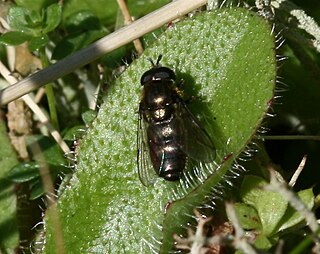
Pipizella is a genus of Hoverflies, from the family Syrphidae, in the order Diptera.

Trichopsomyia is a genus of Hoverflies, from the family Syrphidae, in the order Diptera.
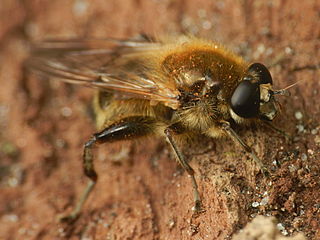
Brachypalpus is a genus of hoverflies, from the family Syrphidae, in the order Diptera. The head is triangular and produced well forwards and somewhat downwards. The thorax and abdomen with pile often rather long. The hind femur is swollen and with an obtuse spur apically and ventrally. The hind trochanters of male is spurred.
The larvae are of the rat-tailed type feeding on decaying sap under tree bark. Larvae live in decaying trees and logs. Larva and pupa have been described by Malloch.

Anasimyia contracta is a European species of hoverfly.
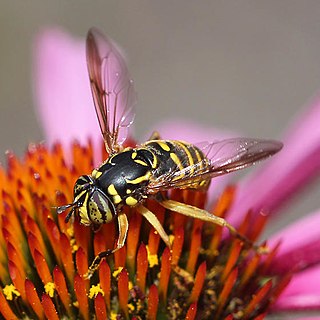
Spilomyia citima, the Western Hornet Fly, is a rare species of syrphid fly first officially described by Vockeroth in 1958. Hoverflies get their names from the ability to remain nearly motionless while in flight. The adults are also known as flower flies for they are commonly found around and on flowers, from which they get both energy-giving nectar and protein-rich pollen. The larvae are known as the short-tailed larvae suited for moist areas such as rot holes of trees.

Sphecomyia is a genus of hoverfly in the family Syrphidae. There are about 16 described species in Sphecomyia.

Anasimyia chrysostoma, the lump-legged swamp fly , is a fairly common species of syrphid fly observed across the United States and Canada. Hoverflies can remain nearly motionless in flight. The adults are also known as flower flies for they are commonly found on flowers from which they get both energy-giving nectar and protein-rich pollen. Larvae of this genus are of the rat-tailed type living in aquatic environments.
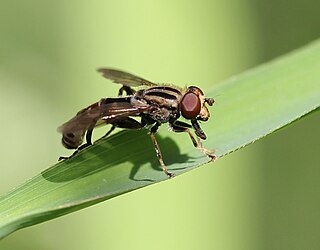
Anasimyia distincta, the short-spurred swamp fly, is a rare species of syrphid fly observed in The Northeastern United States and adjacent Canada. Hoverflies can remain nearly motionless in flight. The adults are also known as flower flies for they are commonly found on flowers from which they get both energy-giving nectar and protein rich pollen. Larvae of this genus are of the rat-tailed type living in aquatic environments.
Total of 245 species either found or highly expected to be found in New York.



